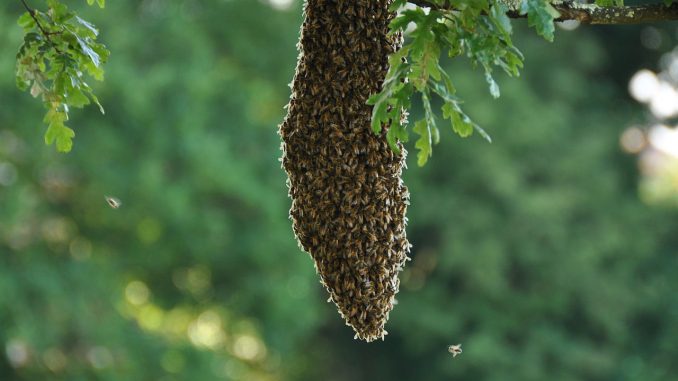
| After the record April sunshine some colonies have built up powerfully with some hives with 4 supers, whereas at the other end of the range some are just into their first one. As usual there are wide differences with colony build up during spring. The dry weather did slow down honey flows and in some cases stopped it all together. Bees working OSR brought in little honey before the recent rainfall; either because of lack of rain or the type of OSR grown (hybrid versus conventional variety). Looking at the fields of OSR most have finished flowering so it is time to extract the crop before the honey sets in the comb. A good way to check a frame for ripeness is to shake the frame sharply with the comb held horizontally. If honey falls out it is not ready to extract.
Now we are into May the peak swarming time is with us. That means that inspections are vital to check if a colony is about to swarm. To be ready for a swarming colony enough spare equipment is needed to carry out an artificial swarm. Often this means setting up a complete new hive nearby the parent colony. When carrying out weekly inspections at this time of year the presence of queen cells indicates the colony is preparing to swarm. Books tell us that a swarm will issue forth when the first queen cell is sealed. In my experience bees haven’t read all the books so that rule doesn’t always apply. So it is important to inspect colonies weekly as a queen cup containing a 3 day old egg will be ready to seal in 6 days. It doesn’t leave much leeway to stop a colony from swarming. This is why I try to clip my queens; if a colony swarms before the next inspection the queen falls to the ground and the swarm returns to the hive. Sometimes the queen makes her way to the underneath of the floor followed by the swarm. If this happens the swarm can be easily hived by dismantling the parent colony and then knocking the swarm hanging to the underneath of the floor into an empty brood box. There are several options available to us when bees are in swarming mode. See the article on ‘Making nucs’ which describes how a colony with desirable traits can be used to advantage. Follow the link: https://www.bedsbka.org.uk/article/nucs-and-how-to-use-them-effectively/ All beekeepers should try to overwinter some nucs in case there are heavy winter losses so do try and make some up during swarming time. Bees in polynucs tend to overwinter well so they are recommended. They are not expensive and are readily available. Last month I mentioned that I intend to perform pre-emptive artificial swarm control. As ever bee events tend to overtake the best of intentions but I have started with some colonies. Looking at the strongest colonies (ones with at least 2 supers full of bees) I take the box containing the brood and move it to one side. The queen is then caged and eventually put in an empty brood box on the original site (parent colony). This box should ideally contain a few drawn frames to allow the queen to continue laying as well as frames of foundation. A frame of stores and one of sealed brood is also given to the queen – this will provide her with a lot of nurse bees when they emerge. The supers are then placed on the box containing the queen. The box with the brood is made into a full hive which will then produce queen cells. After a week go through the box containing the brood and leave one or two good looking queen cells. Some like to leave a single cell others two for insurance. If the queen cannot be found then the above can be modified. Find a frame containing mainly eggs and shake all the bees off (to make sure the queen is not on it). Place the frame of eggs in the empty brood box along with a mix of drawn frames and foundation. The box containing the queen is moved aside and made into a full hive. This box will need an empty super as the bees will start foraging after a few days and the presence of brood encourages foraging. The supers containing honey are placed on the new brood box (with eggs only) so the flying bees have plenty of stores. After a week go through the box containing the frame of eggs and leave one or two queen cells as above. Finally, do collect all the scraps of wax during the season to render down later in the year. The foundation we stock in the Association relies on members providing wax for the exchange scheme – less wax traded means less foundation can be bought. Keep safe. Wally |
